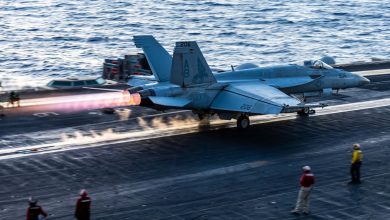Pentagon stages first ‘Top Drone’ school for operators to hone skills
The Pentagon last month held its first “Top Drone” school for drone pilots to demonstrate their skills in a threat-representative environment.
Lt. Col. Matt Limeberry, commander of the Pentagon’s Rapid Assessment or Prototype Technology Task Force, told Defense News in an interview Monday that DOD plans to host at least two Top Drone schools each year.
The goal, he said, is to provide a chance for service members, industry and academia to prove out tactics, operational procedures and drone capabilities on a test course that mimics the kinds of terrain and adversary effects an operator might see in the field. It also allows the department to validate and refine its own counter-uncrewed aircraft system sensors.
“It’s a dual effect of data collect but also benefits the warfighter and industry flying through this threat-represented and emulated environment,” Limeberry said.
For the inaugural, four-day event, the task force set up a training course at the Muscatatuck Training Center just south of Camp Atterbury, designing it to imitate an urban setting and focusing on maneuverability, endurance and reconnaissance. Two companies, Vector and Code 19, flew drones alongside two service partners — the Army’s Combat Lethality Task Force and its Aviation Center of Excellence.
The drones were a mix of untethered first-person view systems and fiber-optic-connected drones.
The department also staged a trial at a separate test range at Camp Atterbury that was supporting T-REX where the Marine Corps Attack Drone Team conducted live fire demonstrations.
Limeberry said he was impressed with how well service members participating in Top Drone performed, navigating and identifying targets. For future events, he hopes to expand the trials over multiple weeks to allow operators to “refine” their tactics against more complex obstacles.
The department is also building a secondary Top Drone course at Camp Atterbury to emulate a more dense, wooded environment.
“As we continue to scale the complexity, it will be an a la carte menu of [electronic warfare] jamming and providing a real-world, adversarial threat-informed environment that we need to fly with and through to make sure that we’re staying competitive,” Limeberry said.
Senior leaders in the Pentagon in recent months have ramped up their drive for what Defense Secretary Pete Hegseth has called “drone dominance.” The intent is for the military services to not only field more drones to operators, but also develop the organizational and training infrastructure to support broader adoption by 2027.
Top Drone supports that push as did much of last month’s T-REX event, which focused on low-cost, attritable attack drones as well as counter-uncrewed aircraft system technologies like interceptors and sensors.
Over the course of the two-week showcase, the department assessed 58 technologies, some of which were sponsored by a military service or combatant command and others brought by firms that had never engaged with the Defense Department but had technology with the potential to address a critical capability gap.
Of those technologies, some number will progress into joint, rapid experimentation and others will require further development and iteration or experimentation. Limeberry noted that DOD has a number of innovation pathways aimed at further maturing technology and T-REX is a good way to identify which route makes the most sense for a particular capability.
“The goal of T-REX is to come out and you find your best transition partner, an innovation pathway that fits the need of your company or fits the need of the government, depending on where the gap and critical need is,” he said.
Decisions about which technologies will transition into the rapid experimentation phase are pending, Limeberry said. He expects the team will brief Undersecretary for Research and Engineering Emil Michael in the coming weeks and have a determination before the end of September.
Along with the technology demonstrations, T-REX also featured static displays from another 50 companies whose capabilities are in an early stage of development. Those capabilities may be considered for participation in future T-REX assessments.
“They were showcasing emergent and urgent capabilities but didn’t have the capacity yet to fully assess and put their prototypes into the environment, so we put them on a prototype technology display,” Limeberry said.
Courtney Albon is C4ISRNET’s space and emerging technology reporter. She has covered the U.S. military since 2012, with a focus on the Air Force and Space Force. She has reported on some of the Defense Department’s most significant acquisition, budget and policy challenges.
Read the full article here









